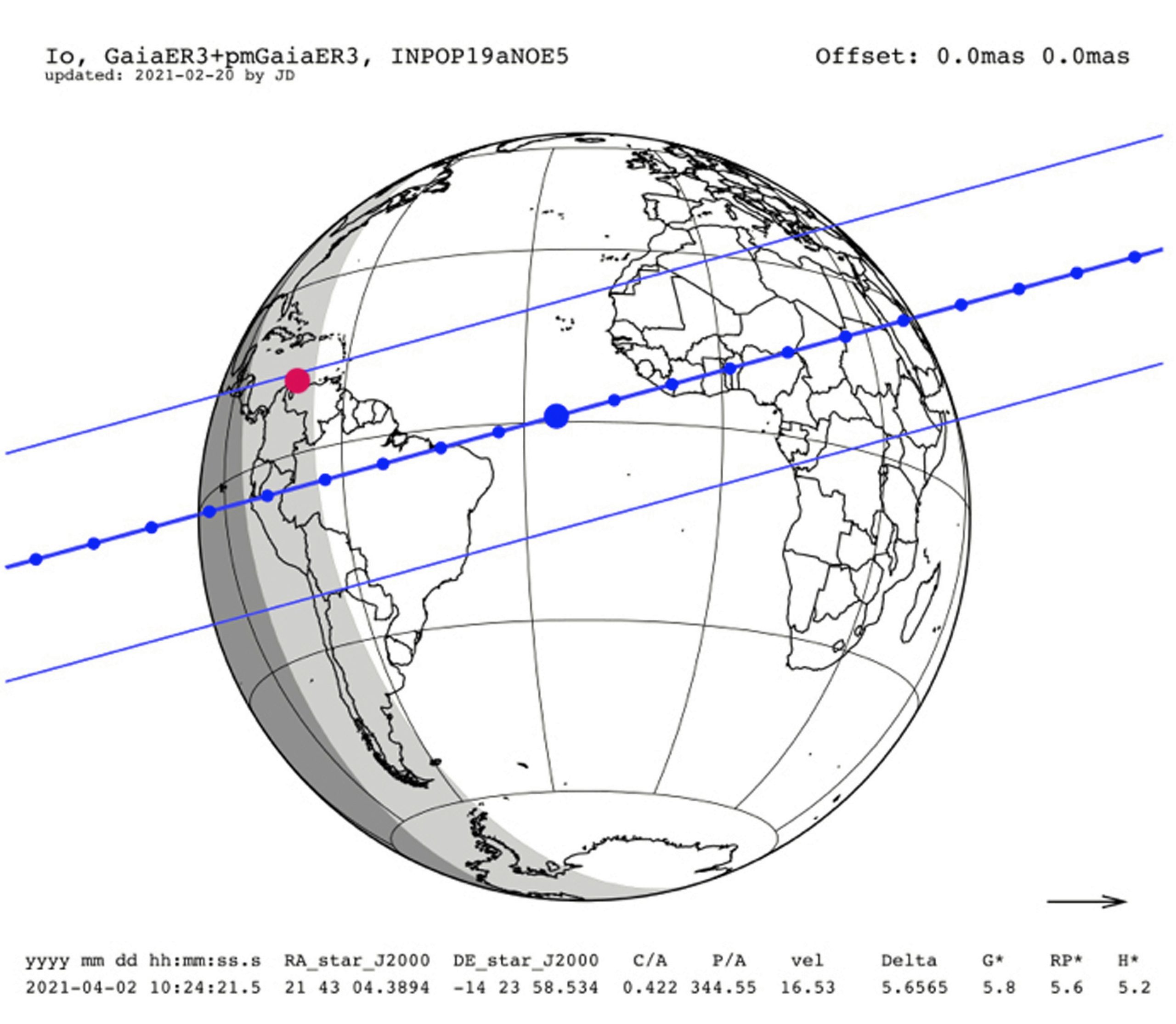Occultation of 44 Cap by the Jovian satellite Io on 2021 April 2
2022 October 6
The occultation of the star 44 Capricorni (44 Cap) by Io on 2021 April 2 was imaged from Curaçao. Occasional overcast and atmospheric blurring hampered an accurate analysis of the event. The time points of the ingress and egress were derived from analysis of individual frames and photometry. We established the ingress time from the photographic data as 10:19:51.7 UT, and from the photometric data as 10:19:54.1 UT (predicted 10:19:52 UT). The egress was timed at 10:21:05 UT (predicted 10:20:58 UT).
Introduction
On 2021 Apr 2, the magnitude 5.8 star 44 Cap, of spectral type G, was occulted by Jupiter and four Jovian satellites (Io, Amalthea, Thebe and Metis). This is a rare event which happens once a century. We recorded the occultation of 44 Cap by Io.
The predicted track of Io’s shadow is shown in Figure 1. This illustrates that the occultation was predominantly visible from South America and Africa.1
Eric lives on the Caribbean island of Curaçao, located at the northern side of the track. The coordinates of the observation location are 12° 5ʹ 37ʺ N, 68° 52ʹ 23ʺ W. For Curaçao, the predicted midpoint of the occultation was calculated to be at 10:20:25 UT and the duration of the occultation 66 seconds (data from the Institut de Mécanique Céleste et de Calcul des Éphémérides (IMCCE)).2 The event occurred shortly before sunrise. During the occultation, the meteorological circumstances were rather unstable and unfavourable due to frequent cloud passages. The low altitude of Jupiter, at 35°, was also a handicap. However, Eric was nonetheless able to record the occultation.

In this communication, the results of the observation session are presented. It was our main goal to record the phenomenon photographically and to derive from these images the times of the ingress and egress as accurately as possible. Although it is obvious that the photometric approach was the most accurate way to determine these times, we wanted to investigate how well the timing could be established using imaging of the event, compared to results from a photometric analysis. Due to the poor weather conditions, a photometric comparison could only be performed for the ingress.
Methods
Using a Celestron C11 (28cm Schmidt–Cassegrain telescope) in its primary focus, with an ASI 462MC camera plus an 889nm methane-band filter to reduce the glare of the planet, short videos (SER format) were captured of two minutes duration, at a frame rate of 10fps. Due to passing cloud there were several interruptions in the sequence, in particular around the egress. The system time of the computer was synchronized with an atomic clock and each frame received a time stamp.
Each SER file was centred with the PIPP program; 25% of frames from the full SER files were stacked with Autostakkert 2.6 and sharpened with the wavelet function of Registax. Final processing was performed with Photoshop CS2. For a photometric analysis of the SER file of the ingress, we employed Tangra 3.6 software.
Results
Ingress
The time course of the changing angular distance of 44 Cap and Io from the western limb of Jupiter is shown in Figure 2. Average stacks of nine individual SER files, each spanning a period of two minutes (about 1,200 frames), are presented and indicated by their average time point. This time series clearly shows how Io (brighter dot) and 44 Cap (fainter dot) approached each other, and that in the SER files 10:19:40.118 and 10:21:33.839 UT, Io and 44 Cap overlap. Table 1 indicates the time intervals covered by each SER file.
To analyse further the two-minute SER file encompassing the ingress of the occultation, file 10:19:40.118 UT was subdivided into groups of 50 frames, each covering a period of five seconds.
(Login or click above to view the full illustrated article in PDF format)
| The British Astronomical Association supports amateur astronomers around the UK and the rest of the world. Find out more about the BAA or join us. |
